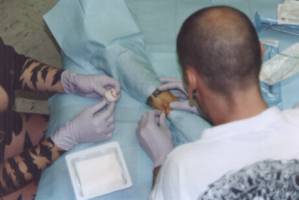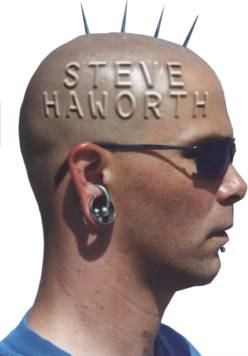
 |
Steve Haworth is the world's leading
and, due to specialized tools and techniques of his own invention, quite
possibly also the world's only three dimensional artist who's medium is
human flesh. With his unique style of subdermal and transdermal implants,
new piercing techniques, "laser"-cautery branding, and sometimes
near-surgical art, he is revolutionising the body modification and
modern art worlds. Steve may be contacted via his HTC Body Adornments Phoenix
location, (602) 278-2149. |
|
STEVE: I
do lots of interesting art with old cars -- I take cut
sections out of old classics that have been totaled and then take
them down to my shop and I'll clean up the edges and I'll weld in
a backing plate and turn it into a couch or a wall-piece or
what-have-you. BME: So you really do a lot more than just the body modification stuff... STEVE: Yeah, I'm an artist... I do all kinds of interesting and weird, extreme stuff. |
STEVE: I was raised in a family that produced medical instruments. From the time I was about 12 years old I was spending summers in my father's manufacturing company. I was the "all work and no play" kind of kid, and when I was in junior high I was taking night college courses and stuff like that.
BME: You were really raised in this industry.
STEVE: Oh yeah... When I was ten and twelve years old I was watching video tapes of the pioneering of what's standard ophthalmic eye surgery today. My father designed a majority of the tools used for cataracts removal and interocular lens replacements. I set up and ran a lot of production lines to produce that kind of equipment.
STEVE: In '86, we sold the ophthalmic manufacturing part of what used to be called True Line Instruments to Coopervision Medical, and they took the plastic surgery (liposuction canula) division and micro-canula and micro-facial work tooling section and dumped it. A couple of months later several of the companies that we had been producing instrumentation for called me up and asked me if I would go back into the production of liposuction canula and I said sure.
I started over, producing medical instrumentation out of a small shop in my garage, and at that time I called it Haworth Med Tech. Roughly '89 or '90 when I started producing body jewelry, and just before that I changed the name to Haworth Tech Company because we were producing a few items other than medical. When I started producing body jewelry we had HTC Body Jewelry as a subsidiary.
BME: The interest in body modification, as in piercing and tattooing, came much after the medical end...
STEVE: Yeah. I always had interests in doing 3-D modification. Everything in plastic surgery is done to change someone to more of the aesthetic norm, unless you're talking about women who have just extremely large breasts (that's not the norm but it's the most desired). Even early on, long before body piercing became a glimmer in my eye, I was thinking of ways of giving people alien looking foreheads.
BME: Did you grow up on Star Trek, or what...?
STEVE: Well, I'm not a Trekkie, but I enjoyed Star Trek. In another interview a woman had asked me what my inspirations were, and I had to think about it for a moment. Of course I said, "Well, Fakir, and Jim Ward... and Star Trek".
BME: Well, Star Trek is forehead modification.
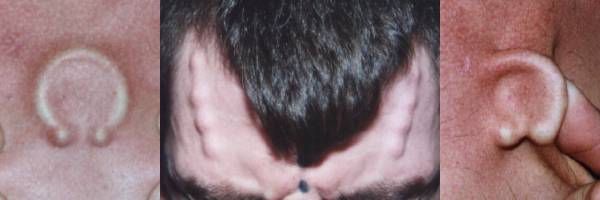
STEVE: Hmmm...
BME: If your other avenues had been less successful would you just have been a piercer or a tattooist?
STEVE: I would have never been a tattooist. I do not have the skills that it takes to be a good tattooist and I wouldn't even think of going there. But if I had not had the background in medical instrument design and manufacturing, it would not have lead me on to where I am now.
BME: You would have just been an artist?
STEVE: I've always done creative things on one scale or another. If I had not gone through the medical manufacturing, I would not have gone on to the production of body jewelry. Had I not gone on to the production of body jewelry, I might have gotten pierced, but I highly doubt I would have become a body piercer because I would not have had the knowledge to do that. Or even the basic starting knowledge. I'm the kind of person that I wouldn't do something unless I was well-versed in that area. So probably I would not have pursued being a body piercer had I not had the background... It started with body jewelry production and from there I became very fascinated in body piercing.
BME: So you made the jewelry before you were actually a piercer...
STEVE: Yes.
BME: Was it just a business decision? Responding to a market?
STEVE: Yes... No... Believe me, the people in the medical industry are extremely, extremely boring. I found body jewelry manufacturing much more fascinating. I immediately took to it and immediately it was "cool, let's take a look at what we can make for this." So it wasn't really financial, it appealed to my artistic side. That sounds corny, but it really appealed to me. It was something I was meant to do.
BME: You've said in interviews that you wouldn't call yourself a piercer, at least not any more... What term would you use?
STEVE: I'm a 3-D artist... 3-D modification. The reason I say I'm not a piercer any more is... unless you have more extensive knowledge in specific areas I do not think body piercers should be doing this kind of work until they have been trained or studied on how to do this kind of work. That's why I've more or less stopped piercing, so I don't give the appearance that this is the next step for piercers to aspire to.
BME: Your detractors sound like they underestimate your background.
STEVE: They have since the beginning. I had an extensive knowledge in the manufacturing of medical instrumentation, and some of that is 316L. As far as the knowledge of producing stainless instrumentation, I had that. I already had half of everything in my shop needed to produce body jewelry. When I started producing body jewelry, Gauntlet was wholesaling a 14 gauge 1/2" captive bead ring for $22. Silver Anchor was wholesaling the same thing for $20. I started at $9. I have never advertised except once in a magazine called "Kinky People, Places, and Things" and that was it. It was just one issue, and it was a friend of mine who was good friends with the editor and just said "throw this in for him". All word of mouth, without advertising. I don't know if I'm the largest any more, but I may be. I've been told mine is by far the largest operation.
BME: Are you mass producing?
STEVE: I don't even think you can mass produce body jewelry. Maybe you could, but there's so much detail that has to be done manually, it's a very labor intensive process. It's all pretty much handmade in a machine shop. I would think if you went to mass production you'd probably lose the attention to detail and quality.
STEVE: Extreme individualism. Ten years ago if you had a piercing or a tattoo you stood alone, and today, even though piercing and tattooing are still a wonderful form of self-expression, you stand in a group. My friend Ralph that has a row of eleven beads up his forearm that looks like backbone vertebrae coming out of his forearm, or Joe with his spike-Mohawk can go to any tattoo convention with 6000 people and they stand alone.
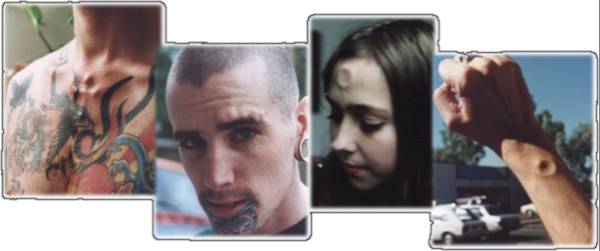
STEVE: First I determine if the person is even a candidate. By candidate, they definitely have to be committed to the lifestyle of body modification and they definitely have to have a clear and definite understanding of how to take care of their piercings. I will not perform anything remotely similar to this on someone who does not have piercings that are somewhat difficult to heal.
BME: But aren't implants easier to heal than a piercing?
STEVE: Oh, they're much easier to heal! But, on the same token, if you have somebody who doesn't have an understanding of how to heal a piercing, they're going to be more reckless, or less caring.
I have a bunch of subcutaneous elevators that I had designed, that are completely unique unto themselves. That not anything like what the medical industry uses, but that's also because the medical industry doesn't install anything like what I use. That's why they're kind of unique onto themselves.
| I've never had an implant reject. I've never had a case of numbness anywhere larger than within a 1/4" from the incision. I've never had a case of any kind of muscle loss. I've never had a case of actual infection. One guy, two days after he got it done got into a fight with his girlfriend and she cracked his wrist really hard, causing it to bleed and it filled up with blood, and so he got freaked out and went to the emergency room. Of course they got freaked out and they pulled it out. |
STEVE: Oh, no... Far, far different than that. I developed a subcutaneous elevator for doing forehead surgery. People that have very deep wrinkles in the forehead, this goes in and it completely cuts all the connective tissue in the subcutaneous area. Then they put on a compression garment, it refibroses back down, and you don't have a third as much wrinkles as you once did. I also helped in developing a subcutaneous elevator to do a neck surgery where they go in and remove the fat pad under the neck (the double chin) -- I developed one of the liposuction tools that works in that area, and then the elevator that makes a complete skin flap from stinal cortum to stinal cortum muscle. And again, they put on a compression garment and it refibroses back down. A majority of the work that I did revolved around producing instrumentation that would create the least amount of trauma possible. Having that, going into the field of body piercing, the way I modified the old method of piercing, was to make it less traumatizing on the local area. (Just in a small way, it's just a slight design difference in the way the tools were used.)
BME: How reversible are beadings?
STEVE: Very. My fiancee as a matter of fact, we've been in and out of her wrist three times in a row. The first time was five beads, the second time was five larger beads, third time was a captive bead ring instead of beads. As far as reversible, in most cases it's easier to remove than to put in.
BME: How many of the bead implants have you actually done?
STEVE: To date, off the top of my head, I would have to say 150 to 175, on about 130 or 140 individuals. A lot of these, probably 30 or 40, were on the penis.
BME: And you do that slightly differently than the traditional pierce and taper insertion method?
STEVE: Yes. It's one opening, subcutaneous elevator down the length of the shaft, and then all the beads are put into one opening and then sutured. Then the beads are taped into place.
BME: I noticed there's virtually no scarring from the suturing, even on Enigma's forehead, where repeated incisions have been made?
STEVE: Yes, I've been in there a total of ten times, five per side. Standard stitch. Your placement of your stitch are crucial to keep the minimal amount of scarring.
BME: What do you charge people for these types of implants?
STEVE: It varies. It depends on the implant. To give you an example, if you wanted horns, subcutaneous horns on your forehead, I would charge $600. That covers the implants and procedure, first and second generation. After that, if you wish to go larger, it's $300 per generation. $150 per side.
| Plastic surgeons are so brutal. They are so incredibly brutal and I get horrified when I see stuff that they do. I usually show people a subendural menoplasty just so that can sit there and go "oh my god!". |
BME: And how long does a procedure like that take?
STEVE: Depending on the individual... Everybody's fibrous layer is different. Some people the elevators go through there like a hot knife going through butter, and it's just the easiest procedure in the world, maybe taking a maximum of ten minutes. Other people can be a lot more difficult to work on, it might take as much as half an hour.
BME: Is that very painful, or is it done under an anaesthetic?
STEVE: I have an RN here in town who will come in and administer local. Otherwise, people who I've done it on who did not have any kind of local at all, say that the actual making of the opening is like a piercing, and the subcutaneous layer is a non-vascular area, so 75% - 90% of the time (of course we'll map out the epidermal and look for any vessels in the area so I don't cut through anything major) they are almost bloodless. Again, in the subcutaneous area, there are no nerve endings. You will feel the fibers that connect the epidermal to the fascia getting cut, but it's just a dull stinging sensation. I've gotten, "wow, that wasn't that bad" to "wow, that was the most painful thing I've gone through", so it varies from individual to individual.
BME: What should a person expect in aftercare and healing?
STEVE: A little bit of swelling for a couple days, if I'm doing any kind of work in the head, whether it be forehead or the top of the scalp, I make them go to their doctor to get on an antibiotic prescription. In most cases the doctors recommend Keflex. As far as aftercare, keeping the stitches very clean, anti-bacterial soap, real mild soap scrub, keeping a close eye on the area, making sure that there's no additional swelling.
BME: What sort of risks are there?
STEVE: Depends on which part of the area we're working on. Risks in forehead: With any procedure there's a risk of infection. We can sterilize our instrumentation, we can make the area that we're working around aseptic, we can control to some small extend airborne pathogens, but otherwise that's the max of what we can do. There's a lot of areas in the sides of the head, certain areas in the safe, and so on, that I will not work on, because there are nerve channels that run in those areas that control muscle function. I will not put an implant anywhere in the cheek area, I will not do any work on the side of the head, near the temple. Pretty much in the centre of the head, you're really super safe. You don't have any nerve channels that cross from one side to another. They all run up along the side of the head and then you've got peripheral nerves that run up along the top of the head. The forehead is an amazing area, there's quite a few places in the forehead that you can just peel off and put back on, and you're not going to damage any nerve channels.
One of the elevators that I had made I sat in a procedure, where her eye spacing was too far apart. They used this tool to completely skin down the forehead, down the eye sockets, remove the section right out of the centre, cut down the sides, pull it all together about 3/8", tie the bone back in, and suture it all back up. She had complete and full control of all the muscles in her forehead and her eyebrows. So that area, the connecting points are right where the eyebrows meet.
BME: How do you look for nerve channels? I realize there are anatomy books, but it does differ from person to person.
STEVE: Yeah, it does. The way that I get around it is I just don't go anywhere near where they are. It's that simple. I do have this interesting little tool that has a tiny electrode and anode on it, and you can touch different areas of the skin until you hit a nerve channel and then the muscle flexes.
BME: You mentioned 316L as a material... What other materials have you used?
STEVE: Teflon. I can make elaborate designs out of surgical stainless; I've made ankhs, I've made crosses.
BME: The stretching; you're basically just putting one in, taking it out, putting in a bigger one, and repeating?
STEVE: Yeah, I wait about two months between generations.
BME: How far could you carry that?
STEVE: We have Enigma up to 7/8" off the forehead. When we started the thickness of his epidermal in that area was about 3/16", and now it has thinned down to 1/8". It doesn't show any evidence of rejection in any way. It has thinned and I would not be comfortable pushing that any further. I would not want to see continuing thinning of the skin. Hypothetically that would create a rejection.
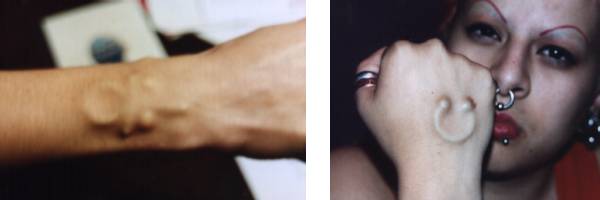
STEVE: I'm really, really, really apprehensive about doing work on the back of the hand. Everyone who I've done the work on the back of the hand, I've told them what the possible risks are. There's no real pressure on any of the tendons. The backs of the balls have been removed so that it's flat on the backside. As long as there's no actual topical pressure on the tendons I don't foresee any drawbacks of working in that area. The only drawback is a possible loss of sensation to some of the tissue on the back of the hand. So far out of the eight pieces that I've done in the back of the hand nobody has had a single problem in any way yet.
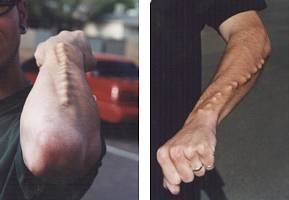 BME: I noticed that the spacing isn't 100% even in Ralph's arms [right].
BME: I noticed that the spacing isn't 100% even in Ralph's arms [right].
STEVE: It's almost impossible to make them perfectly spaced. You
can't get them perfectly spaced. I don't want to drill a hole
through to run a suture through, I don't like the idea of having
that hole there.
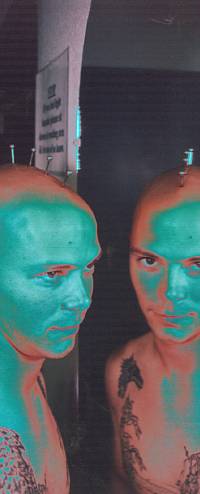 BME: Is Joe the only one you've done?
BME: Is Joe the only one you've done?STEVE: He's the only one I've done so far. I've probably had about twenty people who've really been pushing me to get that done. I'm real sketchy about doing that one.
BME: I'm guessing it's one of the hardest ones to heal?
STEVE: Yeah, of course, it's just like healing a very large surface-to-surface piercing, minus there will not be rejection. You only an 1/8" hole, and you have a backing that's 1/4" wide and 3/4" long, so it's never going to reject. The post itself is sandblasted and then the skin bonds to it, just like it does a fingernail, and you have a little crick around it, and the body encapsulates the rest of it.
Again, it's a transdermal implant, if you're not careful you could track infection in there. The odds of you walking around with that kind of an infection long enough for it to actually make it through the skull, and get to the membrane and then to the brain, before you would go into your doctor and get antibiotics, I can't imagine anybody being that dense to allow it to go that far. I've heard people use that argument, "that person, that infection could track down..." Well, if you're stupid and you have this, I could see that happening, yeah. But again, that's why I'm very picky on who I do that kind of work on.
BME: How long has Joe had those for now?
STEVE: Probably almost two years now. They're beautiful...
BME: Any problems?
STEVE: No, none at all. The only thing that ever happened was when he was jumping into his truck and he bumped the last spike and it did exactly as I designed it to do. The guy goes skydiving seven or eight times a week! He puts those things through hell. His skydiving helmet has a little groove cut out the centre, it's funny on the inside, and he races bullet bikes. He's a crazy kid. The least of his worries are the work I've done on his scalp. He's broken his back twice from landing wrong skydiving, he went down wrong a month ago and he's walking in a brace for his foot.
BME: But the whole time the scalp piece was perfect.
STEVE: Oh yeah...
He kept it really clean. One of the important things in getting this kind of work is to have a very good and understanding doctor. His doctor will prescribe him antibiotics at the drop of a hat. Since he's had them he's only had to take antibiotics the first time.
BME: Could you tell me the whole story of Joe's spike accident...
STEVE: In the design of the spike I had designed the base implant out of 316L, the spike itself was out of 316L, but the thread that runs through the middle of it all is out of 303 stainless. 303 stainless is a much softer grade of stainless than 316, so that if he ever did hit his spikes, he would pull the thread out and disfigure the thread rather than tear his scalp.
STEVE: One day Joe was hopping into his pick-up and his cellular phone was on the seat so he did an extra high jump and in the middle of the jump he realized, what have you done, smack, and knocked out the rear spike. He came on down, checked him out, it was looking a little red in the area, but there was nothing torn, nothing bleeding. We removed the bad thread, put in a new one, and ten minutes later he was on his way.
BME: I think it's really important that people understand the design considerations that went into this.

BME: What are the advantages and disadvantages to the laser branding, in comparison to traditional branding?
STEVE: You can make a line as thin as a little under 1/16" to as wide as the entire width of your leg. You can follow any design. I branded a '49 Mercury on a guy's leg, complete with highlights in chrome. It's my favorite piece. I hate to talk about my own work like this, but it's phenomenal. One of the body lines that goes up it starts at 1/16" and gradually tapers up to 1/8" and then tapers back down to almost nothing in the back. The way the grill was done, they go from a thin line to a point, and back to a thin line, in a nice row of about 20. There's no way you could accomplish something like that with a strike brand. A strike branding kills all the cells in an area, the heat that's still in the flesh radiates and kills even more cells, that's why you have the spread. With the cautery scalpel (I like to call it a cautery laser -- it's not a laser, but generally when I try to explain to people how it works I say laser so people can understand and relate)...
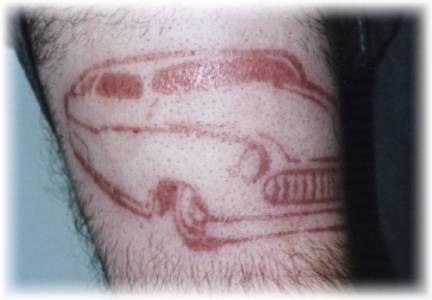
STEVE: If you don't know how to properly use an electrocautery unit, you're going to cause someone to go into cardiac arrest, depending on where you're using it.
BME: What medical support do you have around you?
STEVE: I usually have two or three people assisting. As far as medical support, you're not going to have somebody going into anaphylactic shock off of the cautery unit. They might go into a mild state of shock, but it's not anything that going to have any kind of severe allergic reaction to. I have yet to have anybody have any kind of a serious problem. Again, when I use the unit, it's on people who have been tattooed, who know what pain is all about, this isn't going to be a surprise to them. I would say it feels like a heavy-handed tattoo artist. I did a piece on myself about two and a half years ago, three years ago, just so I would understand what I am doing on other people. So I would understand what they are receiving.
BME: Healing and aftercare...?
STEVE: What I recommend is once it develops a scab, real simple, peel it off. Pick it. Make sure you've scrubbed your hands with anti-bacterial soap, make sure the area's clean. This is to build up the scar tissue. Some people who don't have any keloids on the body, and they're hard-core Anglo-Saxon white, not anything but smooth as silk skin, can actually achieve a raised scar. Not everyone, but that has been proven time and time again, that if you are constantly removing the scab, forcing that to scar more and more and more you will have a bit of a raised scar.

STEVE: If it fits into the diameter of my fist, it's $75.
BME: So is it priced analogous to a tattoo?
STEVE: I'm not even sure what tattooists charge for their tattoos. I didn't base it off of tattooing. I based it off of the size that I'm going to cover. I'm not going to charge by how intricate a piece is, or by how simple a piece is, it's just depending on how much space it covers.
If it's inside the space of my fist, it's $75. If it's within the diameter of my open hand, it's $150, and if it's larger than my open hand, it's $200, unless it's a full back piece. I've been asked why, and simply because I'm not greedy. It costs me roughly $23-$25 per branding, for the disposable grounding pad, the disposable pencil, and the additional tip. So when I do a piece that's inside my hand I'm actually netting about $50.
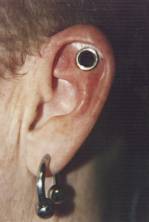 BME: Cauterizer-piercing... advantages/disadvantages vs. a dermal
punch?
BME: Cauterizer-piercing... advantages/disadvantages vs. a dermal
punch?
STEVE: As far as a dermal punch there's no real difference. A dermal punch cuts out a large chunk of cartilage, and you put a slightly smaller eyelet in, and it heals rather quickly because the body does not have to recess the cartilage away from the piercing. Same thing with the cautery, the only difference is it's generally a bloodless process. The only advantage is blood.
BME: Does that affect the healing?
STEVE: I don't think it affects the healing at all. I've done dermal punched cartilage as well. About six weeks is average.
BME: You've done it on lobes as well as cartilage?
STEVE: Yes. I'll cut what looks like a super-thin football shape and then because there's no scar-tissue there the lobe will stretch immensely.
BME: And have you used it on any other part of the body?
STEVE: We bored an eight gauge hole through the head of Joe's penis, to do a reverse PA after his subincision. It worked out really well. It vaporized the hole, so there was no pressure on the jewelry, so it seemed to heal within a two month time period.
STEVE: I've done six.
BME: Is that exploding interest-wise? As far as BME goes, that's one of the most common serious modifications.
STEVE: I don't have very much call for that. I do every once in a while get an email on it, or someone calls me, but I'm pretty sure you've noticed there are quite a few more people than we even realized in the beginning that are into very hardcore genital modification.
BME: I would estimate tens of thousands in North America at least.
STEVE: Yes, I would agree.
BME: And most of them don't know the others exist!
STEVE: But most of them fantasize about it, and like to talk about it, but in all reality, for most of them it's a fantasy and that's where it's going to stay. That's why I think I haven't done that many subincisions. I get a lot of people who are interested in it, who say "I'm interested, and I'll get back with you". There's one guy that I'm very good friends with, that's one of the most powerful men in the Arizona state government. For five years we've been talking about his subincision -- Weekly. It's a fantasy, and I don't think it's going to go beyond that. When I originally bought the cautery scalpel I bought it so I could do a subincision on myself.
BME: And did you do it?
STEVE: I didn't do it. I've changed gears -- I've been working on developing a new kind of bead implant for the penis. Rather than doing beads, I'm going to do stainless steel rods that fit the contour of the shaft. On the bottom, on the sides, or on the top. They're going to be 3/4" long and rounded on the ends. I've actually done one of these so far. Doing them that way it's going to be the old-fashioned piercing needle and taper technique. The techniques that I use would not lend itself to that style. I've already got seven or eight people over the next two months that I'm going to be performing this style on.

STEVE: On Enigma's wife, Katzen, we completely removed the entire lower earlobe. To make it pointed we reformed the top. Three tiny incisions; I go in under the skin and completely separate the cartilage in that area, in three strategic areas, and fold it over, and tape it up with medical tape. About a month and a half later no more need for medical tape; it's completely healed in shape.
BME: What are the risks? Are you fooling with the structural integrity of the ear?
STEVE: Where I work at, it's not any part of the ear that holds it out, it's just at the top of the ear. In that area, the only structural integrity is to hold that part of the ear up which is what I cut to make it fold over anyway.
BME: Obviously this is rumor, but I heard that you botched an ear reshaping and collapsed someone's ear.
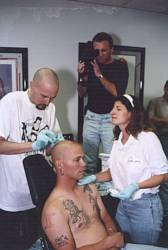 Steve at work, "rip-roaring drunk" |
There was a big rumor going out that I destroyed Enigma's ear. I did his horns and he was really pushing me to do spikes in his ear; cut out triangled sections, where what would be left would be rounded spikes going around. I said, "Bluey, I think you've had enough", and he said, "no, I really want to do it." And then I started and we got in maybe 1/4" and he goes "ok, you're right, I do need a break, we'll do this another time." And then from that, him walking around with this 1/4" groove in his ear, completely sealed shut from the cautery suddenly spawned this story that I destroyed Enigma's ear. He gets even a bigger kick out of it because he'll really tease people when they come up to him and go "I heard your ear got messed up". His ears look fine, because they're completely healed back. He goes, "oh my, god, can't you tell, it's destroyed!" So he plays along with it.
BME: There's also the rumor that Michaela was spreading that Joe was drunk when you did his scalp.
STEVE: Oh yeah, that both me and him were rip-roaring drunk...
EAR SECTIONING
BME: How common is that?
STEVE: He's the only one. I drew it up, took the cautery, chop chop chop, and voila.
BME: What was the motivation, it's a very unusual result...?
STEVE: He had a 3/4" eyelet in one ear, and nothing in the other. I told him I could take the cautery and zap another eyelet in the ear, and he said, "no, I want you to cut notches out of it". He's just a unique character. He's a tattooist that works out of Flagstaff, Arizona.
There's a woman that has a Teflon ring in her forehead, and that's his better half. She's a really unique girl. She brought in drawings that she'd drawn when she was five and six years old, and all the woman in the drawings had a jewel in the center of the forehead. She wanted to know if I could affix a jewel to the centre of her forehead and I told her that it could be done, but it would be a transdermal implant, and I really like to stay away from them. I said we could install a ring under the skin, and she could have a jewel cut so that the contour of the jewel fits the contour of the divot in the centre of the skin, and then all you do is lick it and stick it there and it's going to stay on all day. She was very excited, and we did the procedure, and now she's got this very nice jewel that she licks and sticks.
BME: Have you had many couples coming to you?
STEVE: I've done implants in the ring finger of beads wrapping around the ring finger on the top side as wedding bands.
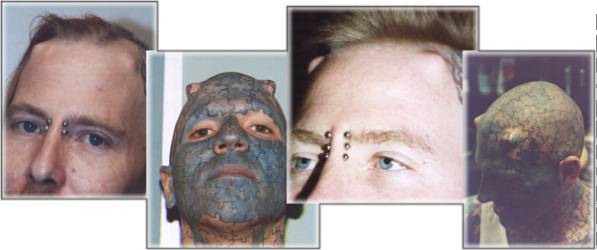
BME: It'll be interesting to see if you can skin them after that and turn them into real horns.
STEVE: From what I know, absolutely. It could cause the bone to heal over, similar to what a fingernail would look like.
What it will do, once the body has assimilated the coral, it grows an entire blood vessel structure inside it, and proceeds to turn it into bone, and removes the existing coral. After it's completely healed, it will heal itself.
STEVE: As far as the common sense and the understanding, a lot of it has to do with my background, but it just comes easy to me. Some people trigonometry comes easy to them. I'll have an idea of something I want to do, I'll think it over, I'll do searching through various medical libraries. I have one good friend that's a plastic surgeon, I'll run it by him. I have another friend who's a neurosurgeon if it's anything that might be near nerve channels I'll run it by him. Neither of these guys will say, "that's not right, this is the way you should do it". What they do tell me is "that's exactly the way I would do it", or "I don't know if that would be the right way to do it or not because it's never been done", or they'll say "you need to go in and study that area just a little bit more." So as far as preparations for new work, I always consult my friends. The more heads the better.
STEVE: You say traditional piercing world, but from what I seem to have found it seems to boil around anyone who has to do with Gauntlet or the APP. Gauntlet was enjoying selling body jewelry at extremely elevated prices and they had a virtual monopoly. I'm not being so arrogant that I'm saying that I'm single-handedly responsible for that ending, but...
I came out, I sold body jewelry at what I thought was a fair price, I'm not a greedy man. When you are enjoying the luxury of selling what should be a $9 captive bead ring for $22, and that is suddenly taken away from you, I can imagine that that would make you very upset. The other issue is, my method of piercing, the way I've redesigned it, it wasn't because of anything except mother is the necessity of invention. I had a medical machine shop outside my back door so I produced some additional pieces to assist with the piercings. I think it's a superior method. It changes the way it's done a little bit. Anyone who's ever had a chance to sit down and watch the method, changes the way they did piercing to our method. I know that this was thrown up to Gauntlet many years ago when I went to my first tattoo convention in San Diego six years ago. Maybe that has something to do with it. Cliff Cadaver and I came up with a new tool to do septum piercings. It also works phenomenally for tongues and Prince Albert piercings. It's what I call my septum clamp, there's two tubes and a pusher bar. I've had it for many years now but I've not offered it on the market because any hacker in the world could suddenly do perfect tongues, perfect septums, and so on. But I'm going to go ahead and start offering it on the market now.
Michaela (Gauntlet) was telling people in her training course, saying "stay away from HTC, stay away from their jewelry, stay away from Steve Haworth, because he makes a tongue piercing gun." The level of unprofessionalism here, trying to associate my forceps with an ear piercing. They're the ones that are supposed to be piercing professionalism. I've sat quietly for years and years and years while they continually try to muck up dirt and mucking up my name. I'm not really knocking them here, I'm just referring to a comment they've made about me. I'm not going to lower myself to their level. It's that simple.
BME: I think the problem isn't really the APP, it's just a couple of the more vocal members.
STEVE: I agree. It's not the APP all together, it's just a few specific people who are in charge of the APP.
BME: I've got photos of spinal piercings up to two years old. Yours are done using surface bars?
STEVE: Yes. They're in our catalogue. I've been working with them for three or three and a half years.
STEVE: Yes. I have quite a few people who root for me, and I really appreciate their support.
BME: What risks are you running as far as "practicing medicine without a license", and that whole class of things?
STEVE: There's two ways to look at that. (a) If a doctor were to do what I'm doing, by AMA standards, they would lose their license. (b) What I do is art. I am an artist, and as I said on national TV, "flesh is my medium". That bill that was passed, "art because I say it's art", back in the thirties... As an artist, and a self-proclaimed artist in what I do in my area of art, I am guaranteed my art by the first amendment. Everyone that I perform art on does it very willingly and it's their choice.
BME: The only thing that's limiting you are your personal limits and you can't cross too far into what doctors are doing?
STEVE: I'll never do anything that goes into the bone itself. I will never do anything that goes the fascia. Other than that I'm wide open.
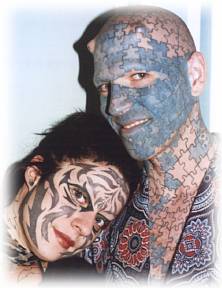
STEVE: The only people that I can think that would cover under that are Katzen, Enigma, and Lifto, and that's exactly what they want people to think. So in that case I can see where that would be felt. But with Joe, maybe Joe is a freak, but he couldn't be more Joe. And Joe doesn't do it for attention.
I think that to me, the only people that I care about what they think as far as my three dimensional art, are the people in the body modification community. Therefore, what people outside the community think, I really don't care, because what my art is about is extreme individualism, and it all revolves around the individual. Therefore, I really don't care what society thinks about the individual, as long as the individual has what they need, or what makes them happy.
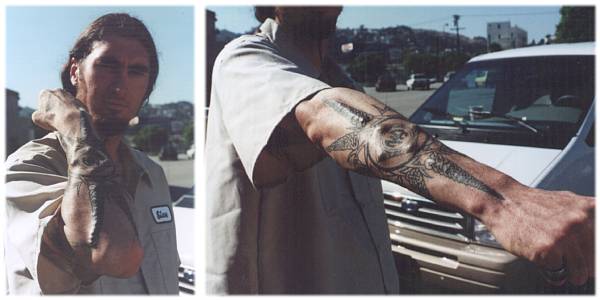
STEVE: I always clearly state and go into detail, that what I do has absolutely nothing to do with body piercing, that the tools, the techniques are completely different. I go into the fact that you need a great deal more training, and background in specific areas than is required in body piercing. I usually explain that the biggest misconception about my three dimensional art is the association with body piercing. That is why I have more or less stopped doing body piercing, so that I won't be known as a body piercer that does this kind of work. I don't want the public to get the misconception that body piercing and three dimensional modification / art are the same thing.
BME: But one day you will start training people, and it's a safe assumption that those people will be piercers... There definitely is a connection between the two.
STEVE: The only reason for the connection is because both are fields of body modification. If you're not into body modification in one way or another, you're not going to be doing three dimensional modification. Yes, it will be piercers that I will be training, but I could not imagine someone who is not a piercer who would want to go straight into three dimensional modification.
BME: Will you require that your trainees keep the 3-D modification very separate from piercing?
STEVE: Yes, I would. I don't expect them to stop piercing, but I wouldn't want them to perform these kind of procedures in the same environment that they're doing their piercings in. For instance, I don't do any modification out of my studios. I have my dining room in my home set up in a very aseptic environment.
BME: When will you actually start training people?
STEVE: If this is an arrogant notion, I apologize for being arrogant, but once I feel that I have gotten enough notoriety for what I've done then I will move on to train others.
STEVE: The only tool that I use that could be available elsewhere is a scalpel. Everything else I have designed and produced to do this kind of work. I know plastic surgeons that want to be set up with elevators like what I have.
BME: Are these tools all one of a kind?
STEVE: No, I could mass produce elevators, no problem. I mass produced liposuction canula, I mass produced special kinds of elevators for doing surgery in the forehead, elevators for work under the neck, in the cheek area, a very large elevator for use in breast implant surgery.
BME: But if they're mass-produced aren't they available from medical tool suppliers?
STEVE: I highly doubt it. There are so few doctors that do that procedure. I only produced about four or five hundred of them and those went directly to the doctors. Other than that, even if someone were to obtain that kind of elevator, that elevator would not work to do the kind of implant work that I do. It's a totally different system... The use is completely different. It's so small and so sharp that I don't think you could control it to keep it from going through the fascia.
BME: So even if someone could get there hands on it, they shouldn't jump right into using it?
STEVE: If somebody got their hands on an elevator, I would surely hope that they would have enough ethics and morals in their own self to make sure that they are very confident and well educated in what they're doing and what they need to be doing with it. I know that there are people out there who would just jump into that at the drop of a hat, but I am not like that, and I'm always in a mindset that I think everyone thinks like me. It blows my mind to think that people would do that but they would...
BME: Because your work is so public, I'm sure people will try and emulate it.
STEVE: I know. I know it's going to be very difficult, because to obtain the proper kind of tooling to do it, I've seen work that's been attempted by other people who were attempting to copy me, and had done the work with incorrect tools, and even though it was successful, it did not look very good.
One piece I've seen because they didn't have an elevator and they were attempting to do it with a scalpel alone, they couldn't place it correctly in the subcutaneous layer. Some of them they actually placed in the fascia, very deep, and others were so shallow that they rejected out, because it was placed in the epidermal. Another one just had extreme, excessive scar tissue because of all the cutting that they did that was scraping the epidermal and the fascia.
The elevator will specifically cut in the subcutaneous layer, it will not cut through the fascia, it will not cut through the epidermal, it will not do any excessive cutting or scarring, or any kind of trauma to the fascia or epidermis.
STEVE: I don't think that will ever happen. To give you an example; surface to surface piercings: very big among piercers, and very big amongst hardcore enthusiasts, but you're not going to see your local sorority girl who has her navel pierced go down and get a surface to surface barbell in her forehead either. So amongst the people who are into the extreme of it, I could see it being very popular, but in all reality, the people who are into the extreme of it, as a whole, make up a very small group.
BME: It already is I guess...
STEVE: A majority of my work, I'd say 90%, is on tattooists or piercers.
STEVE: That's a good question. As far as three dimensional modification goes, in body art, for me I really don't know if there is a next step. I'm only going to do three dimensional body art. I'm not going to do anything that a doctor does -- a doctor heals the sick, a doctor prescribes medicine. I'm not interested in healing the sick.
BME: How about if I said I'd like my little finger turned into a second opposable thumb?
STEVE: That's out of my league. I could spend a lot of time studying that, but that's out of my league. I could design that, I could come up, especially with the coral bone grafts, I could feasibly come up with a way to make it work.
Will I ever take it to that I extent? I don't know, I doubt it, but five years ago there were things that I thought I wouldn't be doing that I'm doing today. I won't say "no", and I won't say "never"... I guess I'd have to say "maybe".
BME: Or will you leave body modification and enter other art fields?
STEVE: Even though I don't really do piercing any more, I'll never stop piercing. I don't know if there'll ever be a day when I won't be doing that much body modification.
BME: Will you still be doing this when you're fifty or sixty?
STEVE: Oh, yeah. I'll do it for the rest of my life. Whether I make it my first priority, I can't say, but I'll never grow out of that.
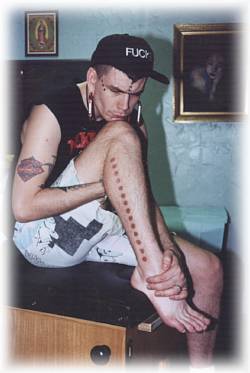 BME: Most of your money comes from the jewelry manufacturing, as
far as profit?
BME: Most of your money comes from the jewelry manufacturing, as
far as profit?STEVE: I actually run HTC on a very low profit margin. Most of my money comes from my piercing, my studios.
BME: How many studios do you have?
STEVE: I had five; we had one in Lawrence, Kansas, and they passed a bill in Kansas saying you have to have a cosmopology license to be a body piercer. That and it turned out that Lawrence, Kansas was not that good an area to put in a studio. It was self supportive, but it was slow, and with that legislation that they passed we just shut down.
BME: Are those piercing only shops?
STEVE: Yeah. I do not mix piercing with tattooing. I also have two tattoo studios, but they're in their own separate addresses altogether. I had tattooing and piercing together in HTC Phoenix for about a year. Tattooing and body piercing are two totally different professionals and I really feel that by mixing them it lowers the professionalism of each. You're mixing two totally different clienteles (for the majority), you're mixing two different kinds of needs for rooms, you're mixing two different kinds of lobbies. A lobby in a tattoo shop needs to look like the lobby in a tattoo shop, and a lobby in a piercing studio needs to be a very, very clean, almost doctor-office-looking place. If you see my studios you'd understand my feelings on it. I keep them very separate.
| In the Crow Part 2, the little girl from part one is a tattooist, and she cuts a date into her stomach. She studied under me to learn how to do scarification for that part, the actress. I don't know if she put any credit in the movie, but she was on MTV and I was also doing 3-D modification at the time she was there to watch the scarification. On MTV she talked about how she had studied under me so it would look as real as possible, and how I was doing this doing this new kind of body art, putting Teflon under the skin, and how she thought it was going to be the whole next world of body modification. |
STEVE: Between my fourteen day-shift employees and my six night- shift employees in manufacturing, the calling-card company I'm in the middle of launching, the magazine that I've been trying to put into being over the last two years...
BME: What magazine is that?
STEVE: It was originally going to be called Epidermal Intrusions. I've gone through two editors and both were a waste of time and money, and in order to do a magazine you have to be on it, on top of it constantly. And I can't do that. It had fallen to the side until just very recently. My fiancee, who's a literary major, is giving it a try, and she has done more in the last two weeks than my first editor did in a year and a month.
BME: Is it going to cover mostly your implant and branding work?
STEVE: It isn't going to be a self-supportive magazine. This is all forms of body modification. I'm not skittish, I'm going to cover everything. This isn't another PFIQ, it's not going to be an HTC promotional magazine, I'm not into that. Of course HTC will advertise the wholesale jewelry and the piercing studios, but we'll have other jewelry manufacturers and studios advertising as well.
And then the nightclub... Arizona is devoid of anything remotely like Seattle or Hollywood or Austin, Texas or Chicago -- There are no nightclubs that cater to pierced and tattooed people. One side of it will probably be all-ages and the other side will be 21 and over. It's been a little bit of a hassle with the state but all the problems have been rectified and it looks like our opening date is going to be April 16.
BME: It's safe to say the "all work an no play" kid has kept that characteristic?
STEVE: Oh, yeah. [laughs]
BME: It doesn't sound like there's any blatantly recreational activity in your day.
STEVE: I really, really enjoy what I do, and what I do is my recreation.
BME: What percentage of the people are getting public work, and what percentage are getting very hidden work?
STEVE: Almost everybody who gets a piece gets it where it can be seen. A lot of people get them in the centre of the chest and you just wear low cut v-shirts and it's in your face. I've done them on the penis which of course isn't very public. I've done a few for people who've said they would probably never show them to anyone.
The ring in my wrist, if the lighting hits it just right, it's really, really noticeable, otherwise, if the lighting's not just right, I could be talking to you for five hours and you would never know it. That's what I like, is being extreme is subtle ways.
I don't know if I should compile a list of books for people to go through, or if that is something I should reserve to just the people that I train.
BME: You're in the difficult position where you know that people are going to try it without your training...
STEVE: Am I going to do the "Implant with a Pro" or am I going to try to keep it secret? I don't want to be the only one doing this, I do intend to train other people.
STEVE: Only about 25% of the works that I do are started in a ritual-like setting. I don't even know if it's as far as what some others carry out, but I do have people who will light incense, who will play special music, will sit there and for thirty minutes before they do it go through breathing, get their endorphins going, and get themselves in a position where they're ready to go. I've had people come in and bless the room, and do rituals in the room, and things to themselves, and I've even had situations where we take the scalpel blade while it's still in it's metal-foil packet, clean and sterile, and will do a ritual with the scalpel blade, as a centre-piece to the ritual before we actually use it on the person.
BME: So it is a very spiritual event for many people.
STEVE: It's very spiritual for me. Some people think that I have no interest whatsoever in the spiritual side of it, but that's not the case. I am very much into it. I go through my own mental preparations whenever I do a procedure. I prefer to have Dead Can Dance playing in the background.
BME: Do you see yourself almost as a shaman?
STEVE: That's how I feel. When I was doing a piece in Denver, and there was a group of probably fifteen people watching and Dead Can Dance was playing and I was so mentally drawn into what I was doing that I guess I was dancing, my body was rhythmically moving to the music while I was doing the procedure. I really didn't even notice until someone said, "my god, he's dancing!". So I very much, when I can be, and into the spiritual aspect of it.
BME: Are you interested in other, less permanent rituals of the body as well?
STEVE: I am fascinated by suspensions, and I am fascinated by watching suspensions, but I don't think I would want to take part as one, either as the person doing or receiving the suspension. I've never done that, I've never closely looked into doing that, I would not be qualified to do that.
BME: Some people get upset when some of these people treat it with a lack of respect.
STEVE: When they turn it into a freak-show. I trivializes it and I don't think that's admirable.
BME: But Enigma and Lifto made their personal modifications a sideshow thing...
STEVE: That's not a spiritual thing though. A suspension is a spiritual thing, a very, very serious, soul-searching thing, it affects you in so many deep ways, and to turn that into anything other than what it is...
BME: It surprises me that you're so into the spiritual aspect. I think people assume that you're not.
STEVE: I'm really not that open about that side of me, and probably never will me.
BME: Like you said, it's not a public event. The spiritual side is very personal.
